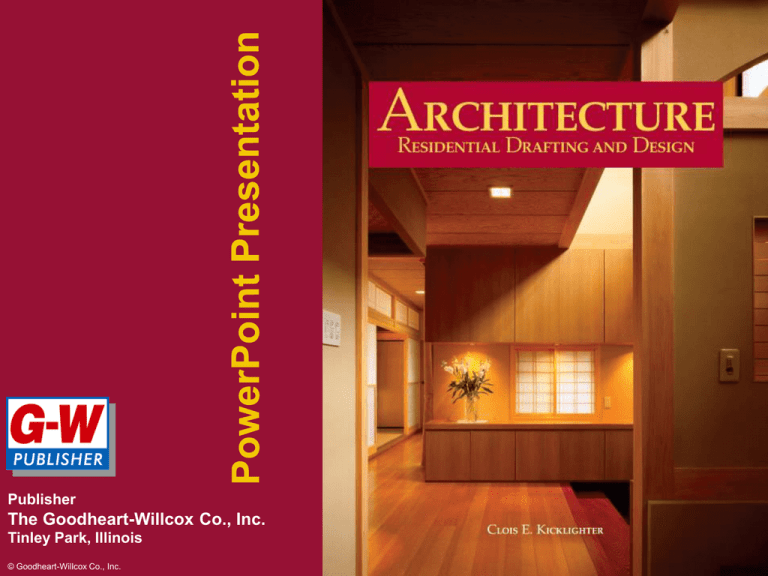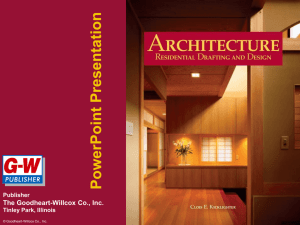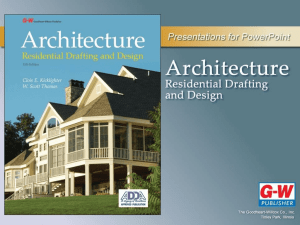Arch15 chapter 15 doors and windows
advertisement

Publisher The Goodheart-Willcox Co., Inc. Tinley Park, Illinois © Goodheart-Willcox Co., Inc. 1 Permission granted to reproduce for educational use only Chapter 15 Doors and Windows 2 © Goodheart-Willcox Co., Inc. Permission granted to reproduce for educational use only Introduction • Doors and windows perform several functions. – They shield an opening from the elements. – Add decoration and expand visibility. – Emphasize the overall design. – Provide light and ventilation. • Planning is necessary to provide maximum design and function. 3 © Goodheart-Willcox Co., Inc. Permission granted to reproduce for educational use only Interior and Exterior Doors • Several door classification systems are used to identify types of doors. – Two broad classes are interior and exterior doors. – Doors also may be grouped according to method of construction, uses, function, or location. • Doors are typically 6'-8" high and available in various widths. 4 © Goodheart-Willcox Co., Inc. Permission granted to reproduce for educational use only Interior Doors • Common types of interior doors include: – Flush, panel, bi-fold, sliding, pocket, doubleaction, accordion, Dutch, and French. • Interior doors should be at least 32" wide for wheelchair passage. • Lever or pull-handles may be easier for a handicapped person. 5 © Goodheart-Willcox Co., Inc. (continued) Permission granted to reproduce for educational use only Interior Doors • Flush Doors – Smooth on both sides. – Generally 1-3/8" thick. – Hollow-core doors with wood frame. – Available in widths of 2'-0" to 3'-0" in increments of 2". – Surfaces usually covered with 1/8" Masonite or plywood of mahogany or birch. 6 © Goodheart-Willcox Co., Inc. (continued) Permission granted to reproduce for educational use only Interior Doors • Flush door and symbol. 7 © Goodheart-Willcox Co., Inc. (continued) Permission granted to reproduce for educational use only Interior Doors • Panel Doors – Frame and panel construction. – Vertical frame members are called stiles. – Horizontal frame members are called rails. – Panels are thinner than frame and fill the space between stiles and rails. – Panels may be wood, glass, metal, etc. – Frame may be made from white pine, plastic, or other woods. 8 © Goodheart-Willcox Co., Inc. (continued) Permission granted to reproduce for educational use only Interior Doors • Left—Typical panel door. • Right—Panel door with plan view symbol. (Morgan Products Ltd.) © Goodheart-Willcox Co., Inc. 9 (continued) Permission granted to reproduce for educational use only Interior Doors • Bi-Fold Doors – Two-part door, hinged in the center. – Supported with conventional hinges or secured to the head jamb and floor with a pivot hinge. – May be flush, paneled, or louvered. – Popular as closet doors. – Installed as pairs (panels 1'-0" to 2'-0" wide). – Heights of 6'-8" and 8'-0" available. – Wood or plastic 1-1/8" thick and metal 1" thick. 10 © Goodheart-Willcox Co., Inc. (continued) Permission granted to reproduce for educational use only Interior Doors • Left—Bi-fold door with panels. • Right—Bi-fold door with plan view symbol. (Morgan Products Ltd.) © Goodheart-Willcox Co., Inc. 11 (continued) Permission granted to reproduce for educational use only Exterior Doors • Residential exterior and interior doors are similar in many ways, but have decided differences. • Exterior doors are generally solid core and thicker than interior doors. • Exterior doors may have one or more glass panels to provide visibility. • Exterior door styles include flush, panel, and swinging or sliding glass doors. 12 © Goodheart-Willcox Co., Inc. (continued) Permission granted to reproduce for educational use only Exterior Doors • These are standard plan view symbols of common exterior doors. (continued) 13 © Goodheart-Willcox Co., Inc. Permission granted to reproduce for educational use only Exterior Doors • Flush Doors – One of the most popular exterior doors. – Wood flush doors are generally 1-3/4" thick and 3'-0" wide; other widths are available. – Doors are made from birch, mahogany, oak, or metal. – Moldings or other decorative millwork may be added to enhance the appearance. 14 © Goodheart-Willcox Co., Inc. (continued) Permission granted to reproduce for educational use only Exterior Doors • This exterior flush door has decorative molding and a large, leaded-glass light. (Peachtree Doors, Inc.) © Goodheart-Willcox Co., Inc. 15 (continued) Permission granted to reproduce for educational use only Exterior Doors • Panel Doors – Exterior panel doors are available in a great variety of styles. – They are constructed from white pine, oak, fir, various other woods, metal, and plastics. – Produced in the same sizes as flush doors. 16 © Goodheart-Willcox Co., Inc. (continued) Permission granted to reproduce for educational use only Exterior Doors • A traditional exterior panel door. 17 © Goodheart-Willcox Co., Inc. (continued) Permission granted to reproduce for educational use only Exterior Doors • Sliding glass door sizes. 18 © Goodheart-Willcox Co., Inc. Permission granted to reproduce for educational use only Specifying Doors • Each door used in a residential plan should appear in a door schedule. – The specifications for each door will appear in the door schedule. – Use manufacturers’ literature for specifications. • Place the door schedule on the sheet with the floor plan or elevations. 19 © Goodheart-Willcox Co., Inc. (continued) Permission granted to reproduce for educational use only Specifying Doors • Typical door schedule. 20 © Goodheart-Willcox Co., Inc. Permission granted to reproduce for educational use only Door Details • Most interior and exterior doors are placed in a door jamb. • The door jamb fits inside the rough opening. • Jambs may be wood or metal. • A jamb consists of two side jambs and a head jamb. • Exterior jambs are usually 1-1/8" thick and interior jambs are 3/4" thick. 21 © Goodheart-Willcox Co., Inc. Permission granted to reproduce for educational use only Door Jamb 22 © Goodheart-Willcox Co., Inc. Permission granted to reproduce for educational use only Windows • Windows – Admit light from outside. – Provide fresh air and ventilation. – Help create an atmosphere inside. – Add detail, balance, and design to the exterior of the house. 23 © Goodheart-Willcox Co., Inc. Permission granted to reproduce for educational use only Window Types • Many types of windows are available. • Most types have unique proportions. • Windows are made from wood, metal, or plastic. • Construction differs by manufacturer. • It is important to obtain window specifications from the manufacturer. 24 © Goodheart-Willcox Co., Inc. (continued) Permission granted to reproduce for educational use only Window Types • Typical windows. (Caradco) © Goodheart-Willcox Co., Inc. 25 (continued) Permission granted to reproduce for educational use only Window Types • Typical windows. (continued) © Goodheart-Willcox Co., Inc. 26 Permission granted to reproduce for educational use only Window Types • There are three basic types of windows used in residential construction. – Sliding. – Swinging. – Fixed. • Combination windows combine two or more types. • Skylights and clerestory windows are location specific. 27 © Goodheart-Willcox Co., Inc. Permission granted to reproduce for educational use only Sliding Windows • Double-hung and horizontal sliding are the two types of sliding windows generally used in residential construction. • Double-hung windows have two major assemblies called sashes. – Each sash may be opened. – Muntins divide the glass area of a window into smaller units. – Mullions are placed between window units. 28 © Goodheart-Willcox Co., Inc. (continued) Permission granted to reproduce for educational use only Sliding Windows • Four different sizes are usually given for each window – Basic unit size: Overall dimensions of the window. – Rough opening size: Dimensions of the framed space in the wall. – Sash opening: Outside dimensions of sash. – Glass size: Inside dimensions of the sash. 29 © Goodheart-Willcox Co., Inc. (continued) Permission granted to reproduce for educational use only Double-Hung Window Details • Unit sizes. 30 © Goodheart-Willcox Co., Inc. (continued) Permission granted to reproduce for educational use only Horizontal Sliding Window Details • Unit sizes. 31 © Goodheart-Willcox Co., Inc. (continued) Permission granted to reproduce for educational use only Swinging Windows • There are four common types of swinging windows: – Casement, awning, hopper, and jalousie. • A casement window may have several sashes or a single sash. – Sashes are hinged at the side and swing outward. – Sashes may be opened using a crank or push bar. 32 © Goodheart-Willcox Co., Inc. Permission granted to reproduce for educational use only Casement Windows (Marvin Windows) © Goodheart-Willcox Co., Inc. 33 (continued) Permission granted to reproduce for educational use only Casement Windows • Unit sizes. 34 © Goodheart-Willcox Co., Inc. (continued) Permission granted to reproduce for educational use only Casement Windows • A dashed line may be used in the elevation to indicate the hinge position. 35 © Goodheart-Willcox Co., Inc. Permission granted to reproduce for educational use only Awning Windows • Each sash in an awning window is hinged at the top. • May have one or more sashes. • Usually crank operated. (Caradco) © Goodheart-Willcox Co., Inc. 36 (continued) Permission granted to reproduce for educational use only Awning Windows • Unit sizes. 37 © Goodheart-Willcox Co., Inc. (continued) Permission granted to reproduce for educational use only Hopper Windows (Andersen Corporation) © Goodheart-Willcox Co., Inc. 38 (continued) Permission granted to reproduce for educational use only Hopper Windows • A hopper window is usually hinged at the bottom and swings inward. • Opened by a lock-handle at the top of the sash. • Usually made as a single unit only. • Popular for basements; directs air upward. • Inward swing is the major disadvantage. 39 © Goodheart-Willcox Co., Inc. (continued) Permission granted to reproduce for educational use only Hopper Windows • Unit sizes. 40 © Goodheart-Willcox Co., Inc. (continued) Permission granted to reproduce for educational use only Fixed Windows • Fixed windows provide a view and/or admit light. • They do not permit ventilation. • Usually custom made. • Do not open. • Examples include picture windows, circle top windows, and special shapes. 41 © Goodheart-Willcox Co., Inc. Permission granted to reproduce for educational use only Picture Windows • Picture windows are fixed-glass units. – They are usually rather large. – Generally frame a view. – Often the center unit of a group of regular windows. 42 © Goodheart-Willcox Co., Inc. (continued) Permission granted to reproduce for educational use only Picture Windows (Pella/Rolscreen Company) © Goodheart-Willcox Co., Inc. 43 (continued) Permission granted to reproduce for educational use only Circle Top Windows • Circle top windows are typically installed above another window or installed as single units. • They are available as: – Quarter circles. – Half circles. – Ellipses. – Full circles. 44 © Goodheart-Willcox Co., Inc. (continued) Permission granted to reproduce for educational use only Circle Top Windows • Left—Circle top window with casement window. • Right—Circle top window with double-hung windows. (continued) (Shouldice/Peachtree Doors, Inc.) © Goodheart-Willcox Co., Inc. 45 Permission granted to reproduce for educational use only Circle Top Windows • Unit sizes. 46 © Goodheart-Willcox Co., Inc. (continued) Permission granted to reproduce for educational use only Window Schedules • A window schedule provides information about each window in the house. • Types of information include: – Type of window and size. – Identifying symbol and quantity. – Rough opening size. – Manufacturer’s identification number. – See example of window schedule in text. 47 © Goodheart-Willcox Co., Inc. Permission granted to reproduce for educational use only










